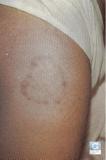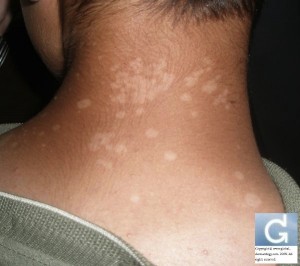Fungal Infections Of The Skin (includes “foot rot”)
Fungal Infections Of The Skin (includes “foot rot”)
Dr Christophe Hsu – dermatologist. Geneva, Switzerland
What is “Pityriasis (Tinea) Versicolor”
- It is made up of fine scaly white patches on the skin. It may appear on your face, neck, shoulders, arms, trunk or legs. These spots are active yeasts infecting your skin. The medical name is Pityriasis versicolor.
What is “Ringworm” ?
- Ringworm appears as scaly, reddish, ring-shaped patches with the tendency to form complete rings with raised borders. This is called tinea corporis (body), or tinea cruris (groin). It is caused by a fungus. It ca also affect the adnexal structures such as the scalp and nails.
What is “Athlete’s Foot” ?
- Athlete’s foot is present when the skin between your toes become very scaly and peels. You will also experience itchiness of the feet. The fungus, which causes the infection may spread to your soles and toe-nails. Then it called tinea pedis.
What is Moniliasis/Candidiasis ?
- This fungal infection is common on the lip area and genitals of persons with diabetes, those taking oral steroids and on long term antibiotics. It is itchy and the rash is red with white flakes. Females may have a genital discharge and itch.
How to prevent superficial fungal infection ?
- Fungus grows when the skin is warm and moist. The space between your toes, the skin folds in the groin and the armpits must be kept dry to prevent such fungal infection.
- Do not walk barefoot in areas where the floor is wet – eg. bathroom, lavatory, and swimming pool as the fungus tends to be present. Wear Slippers.
- Avoid borrowing personal napkins, towels, combs and hair brushes as they may be infected. Make sure you use your own personal items because fungal infections are easily transmissible. Any item that comes into contact with the affected areas must be sterilised before use.
- Nylon socks and covered shoes make your feet sweat. Wear cotton socks to absorb the sweat, or open-toe sandals if your feet sweat profusely.
- Keep a healthy life-style with a balanced diet, exercise and have time for rest, to increase your body’s resistance. You will catch fungal infection easily if you are weak.

Fungal infection of the skin on the legs
How to treat superficial fungal infection ?
- Apply anti-fungal cream prescribed by your doctor on the affected areas 2-3 times a day for 3 weeks. Such creams include nystatin, tolnaftate, imidazole or naftidine creams.
- Do not stop using the medicine immediately after the infection has cleared. Continues using it for at least 7 days after the infection appears to be cleared. In the case of white spots, the white color remains even after the infection has been successfully treated. However, this will gradually fade as the skin recovers its normal colouring.
- Oral anti-fungal tablets are needed for fungal infections affecting large areas. Your doctor may prescribe them.
- For prevention of white spots, use an anti-fungal shampoo once a month on your scalp and body, leaving it on for 15 to 30 minutes before washing it off. In the event of an infection, use this nightly for 7 days consecutively
Contributors
Dr Christophe Hsu – dermatologist. Geneva, Switzerland
National Skin Centre. Singapore
العربية 中文-汉语 中文-漢語 Deutsch Español Italiano Português русский язык Tagalog 日本語
Category : dermatophyte - Modifie le 11.28.2009Category : foot rot - Modifie le 11.28.2009Category : fungal infection - Modifie le 11.28.2009Category : fungus - Modifie le 11.28.2009Category : mycose - Modifie le 11.28.2009Category : mycose des pieds - Modifie le 11.28.2009Category : mycoses - Modifie le 11.28.2009Category : Tinea pedis - Modifie le 11.28.2009





